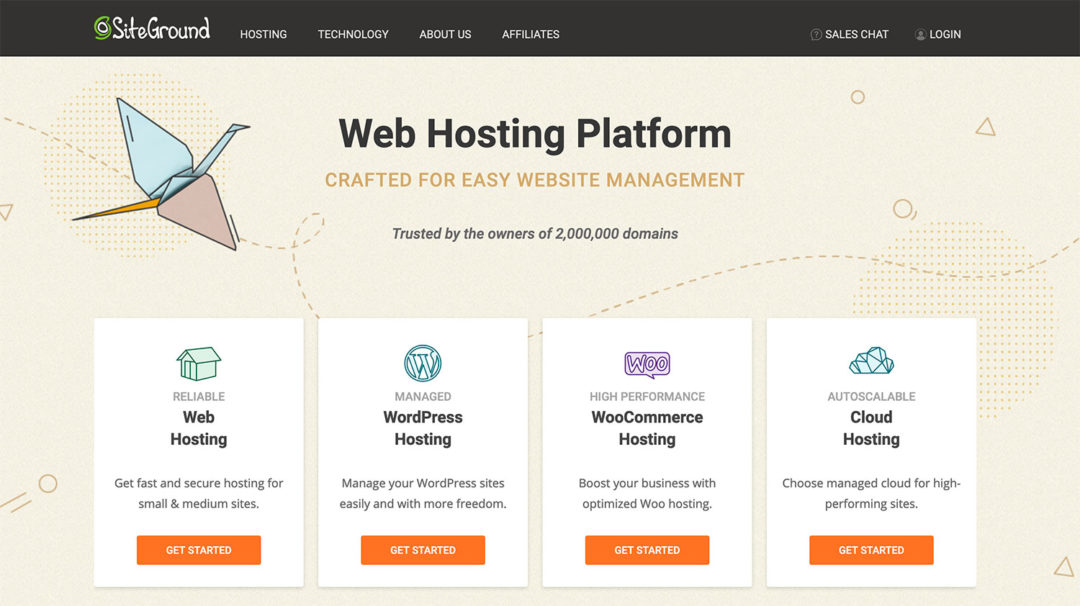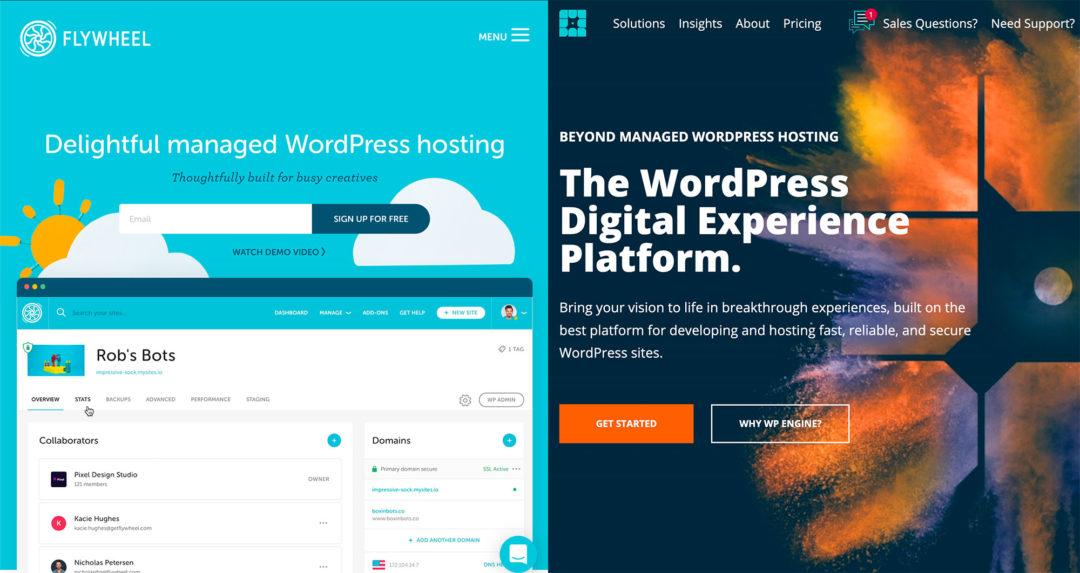SiteGround and Kinsta are two very big names in the managed WordPress hosting space.
If you’re looking for a fast, secure and feature-rich host for your website, they’re both probably on your shortlist. But which one is best?
If you just want the key details, Kinsta is much faster than SiteGround, but also much more expensive. Both hosts are easy to use, but if performance is important to you, and you can afford it, Kinsta is the best option.
To help you to decide, I’ve explored the best aspects of both hosts, highlighted their main differences and covered their most important drawbacks. I also used paid services, such as Pingdom and K6, to test their performance to show you which host was fastest and which one was better at handling spikes in traffic.
Their prices may be a bit higher than cheap shared hosting, but you get a lot more for your money with Kinsta (here’s Kinsta’s pricing) and SiteGround (and here’s SiteGround’s pricing), not least faster loading times.
(Note: For anyone interested in lengthy reviews, here’s our in-depth SiteGround Review and our in-depth Kinsta Review)
Let’s begin…
Kinsta vs SiteGround Quick Comparison
| Kinsta | SiteGround | |
|---|---|---|
| Avg. Load Time* | 1.09 s | 2.85 s |
| Price | $29.17 a month † | $3.99 a month ‡ |
| Websites | 1 | 1 |
| Storage | 10 GB | 10 GB |
| Visits | 25,000 | ~ 10,000 |
| Bandwidth | 100 GB | ∞ |
| Full Details | Full Details |
† 12-month subscription required ($35 if paid monthly).
‡ 12-month subscription required, after which the price increases.
Table of Contents
SiteGround vs Kinsta: Quick Overview
The most obvious difference between these two hosts is Kinsta is more expensive than SiteGround.
With Kinsta, the entry-level plan costs $35 a month if you pay yearly ($29.17 a month if paid monthly). The full price of the SiteGround entry-level StartUp plan is $14.99 a month, but new customers can currently get it for the discounted rate of $3.99. For the performance tests later on in this comparison, I’ve used the mid-range GrowBig plan, which currently starts at $6.69 a month.
Both hosts have other plans. In exchange for their higher prices, those plans let you host more websites, receive more visitors, use more server space and unlock additional features.
I look at the pricing details of Kinsta and SiteGround in more detail later on, but, to summarize, the SiteGround plans are lower priced and you get more for your money in terms of storage, number of websites you can host and visitors you can receive.
However, there’s much more to consider when deciding between Kinsta and SiteGround, such as loading times, user experience and support quality, to name just a few things, and I’ll be covering these areas as well.
If you’re short on time and just want to know which one’s best, jump to the end of this comparison to get my final thoughts.
For everyone else, here are the main features of SiteGround and Kinsta compared…
Kinsta vs SiteGround: Key Features
The main reason to pay a bit extra for premium WordPress hosting is the higher levels of performance available, so let’s look at that first.
SiteGround vs Kinsta: Performance
Better performance means faster loading times and a greater ability to handle large numbers of visitors and surges in traffic.
So, to give you an idea of what load times you might expect, and to find out who’s the fastest out of Kinsta and SiteGround, I ran a few tests to measure their performance.
For the first set of tests, I used Pingdom to measure the load times of my sites hosted by Kinsta and SiteGround. After that, I used K6 (formerly Load Impact) to see how these hosts performed when lots of users were accessing the sites at the same time.
Here are the results…
Pingdom Load Time Tests
I created two WordPress websites with each host. One of those websites used a lightweight theme, while the other used a heavyweight multipurpose theme.
This approach will not only show you which host is fastest, but it’ll give you a rough idea of how fast your website might load if you host it with Kinsta or SiteGround, based on the type of site you plan to build.
Pingdom was set to record the load times of the sites every 30 minutes. After seven days, we had an average load time for each site to compare.
Lightweight Theme Load Time Test Results

For the first test, I installed the free Twenty Twenty-Two theme on the test sites. I then created a basic page containing an image and some text. Pingdom was then set to monitor the speed of that page.
Kinsta Lightweight Theme Test Results
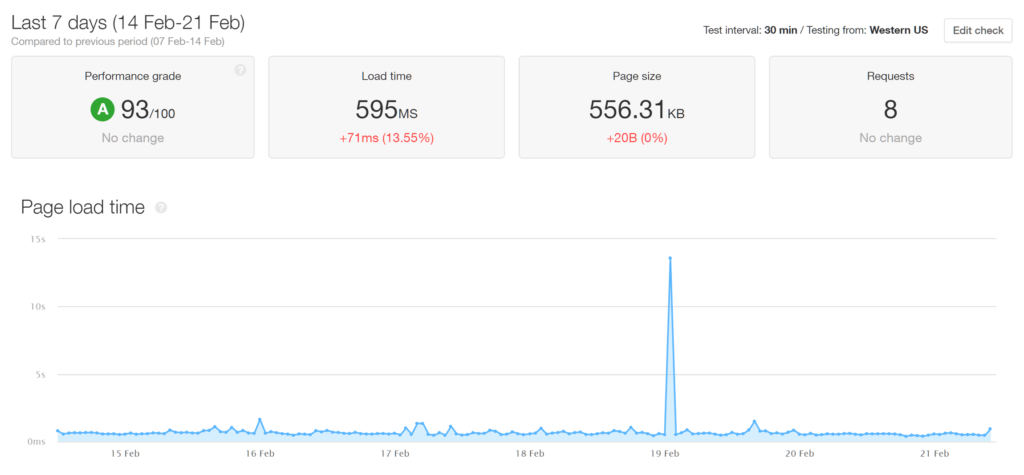
SiteGround Lightweight Theme Test Results
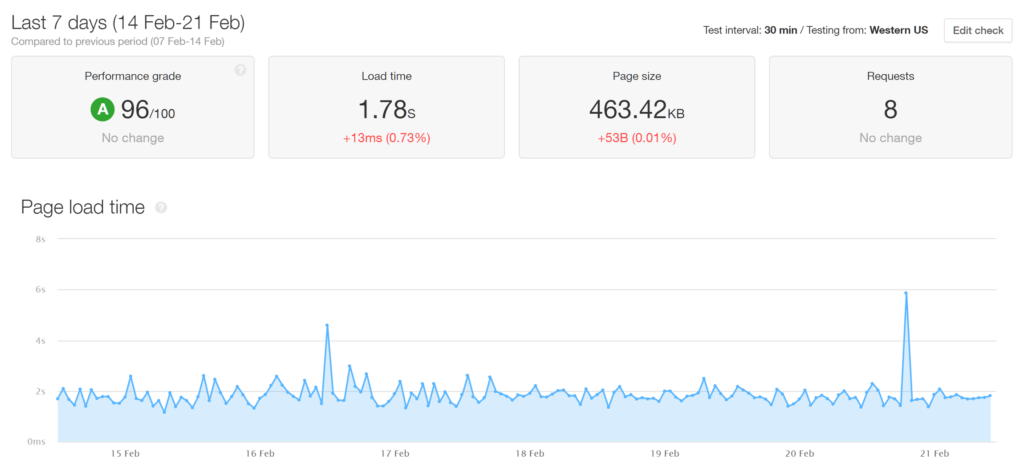
Heavyweight Theme Load Time Test Results

For those of you who plan to use a more feature-rich theme or create a more advanced website, I also measured the load times of two sites using the bestselling multipurpose Avada theme. I imported the Avada Digital Agency demo on each site, then set Pingdom to monitor the load time of the feature-packed homepage.
Kinsta Heavyweight Theme Test Results
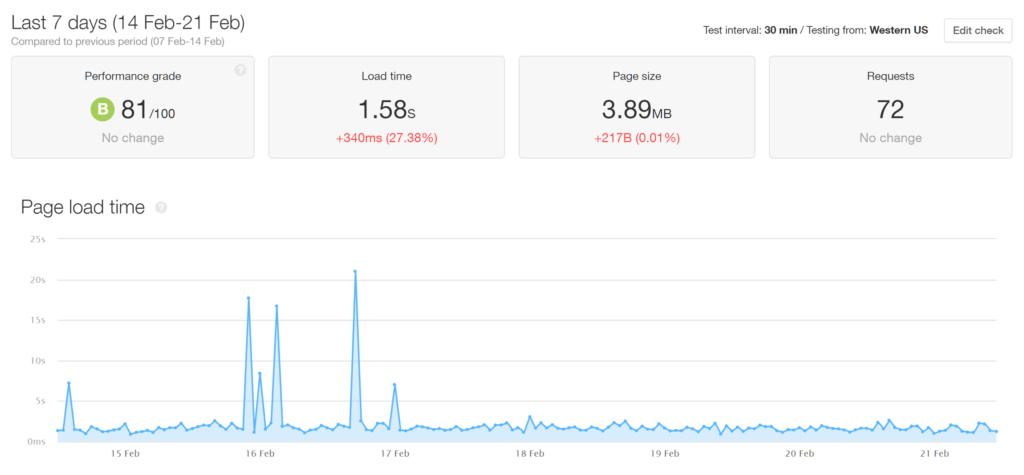
SiteGround Heavyweight Theme Test Results
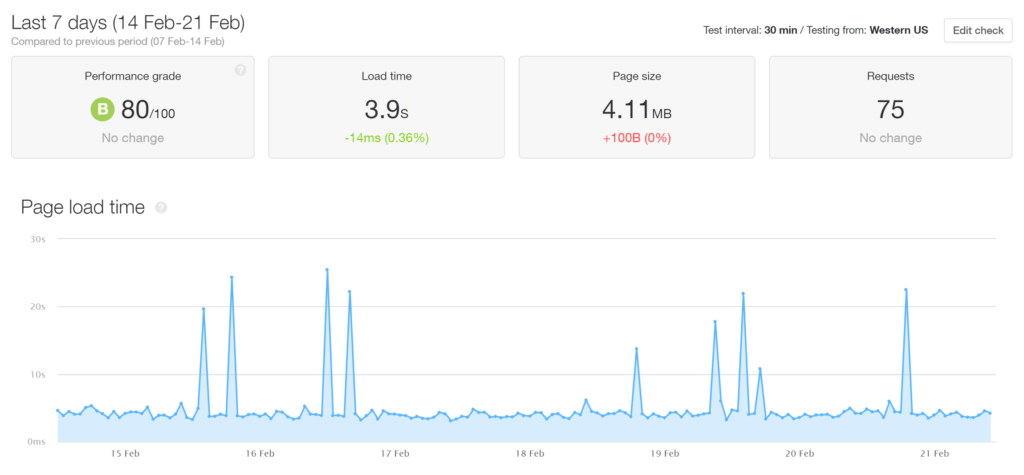
Pingdom Load Time Tests Summary

As you can see from the results, according to Pingdom, Kinsta was faster than SiteGround in both tests.
Therefore, choosing Kinsta over SiteGround makes sense if site speed is your main priority, regardless of what type of website you plan to build.
Pingdom Test Information
For the tests, I chose the testing location in Pingdom that was closest to where each site was hosted. I also didn’t make any effort to optimize the sites for faster loading times beyond enabling the optimization features available via the SiteGround account dashboard. For the Kinsta-hosted sites, I left the preconfigured default settings in place. The CDN features and integrations were enabled for both hosts.
K6 Load Impact Tests
Because the test sites don’t receive any traffic, the load time tests only tell part of the performance story.
For a fuller picture, I used the K6 service to simulate multiple visitors accessing the sites at the same time.
K6 recorded the response time (not load time) of each site while the test was running and the number of simultaneous virtual users accessing the sites increased from one to 199 over a five-minute period.
With this type of test, the actual response time isn’t so important. It’s more the changes in response time as the number of simultaneous virtual users increases that gives a good insight into how the speed of your site may be affected as it receives more traffic. If the response time increases a lot during the test, then you can assume your website will slow down if it gets busy.
For both hosts, the sites using the lightweight and heavyweight themes were tested, including the homepage of the site built using the Avada Digital Agency demo and the sample page on the site using the Twenty Twenty-Two theme.
Kinsta K6 Load Impact Test Result
In the chart below, you can see that as the number of virtual users accessing the site at the same time (represented by the gray area) increased up to 199, the response time (the blue line) of the site using the Twenty Twenty-Two theme remained stable.

In the next test, the response time of the site using the Avada theme and its Digital Agency demo remained pretty stable, or at least didn’t increase much.

SiteGround K6 Load Impact Test Result
The response time of the SiteGround-hosted site using the lightweight Twenty Twenty-Two theme did fluctuate. However, it did come back down after the initial rise.

The SiteGround-hosted site using the heavyweight Avada theme slowed down as the number of simultaneous virtual users accessing the site increased.

K6 Load Impact Tests Summary
As with the load time tests, Kinsta performed better than the SiteGround GrowBig plan in the load handling tests.
However, while there was an increase in response time of the SiteGround-hosted site using the lightweight theme, it did return to normal before the end of the test.
So, while Kinsta did better in both tests, SiteGround was able to handle the load when a lightweight theme was used. Therefore, if you expect to receive 200 or more simultaneous visitors and build an advanced site or use a heavyweight theme and one of its demos, the SiteGround GrowBig plan may not be suitable.
Features Overview and Comparison
Now we know which host offers the best performance in terms of site speed and load handling, let’s compare and contrast the key features of Kinsta and SiteGround.
WordPress Website Backups
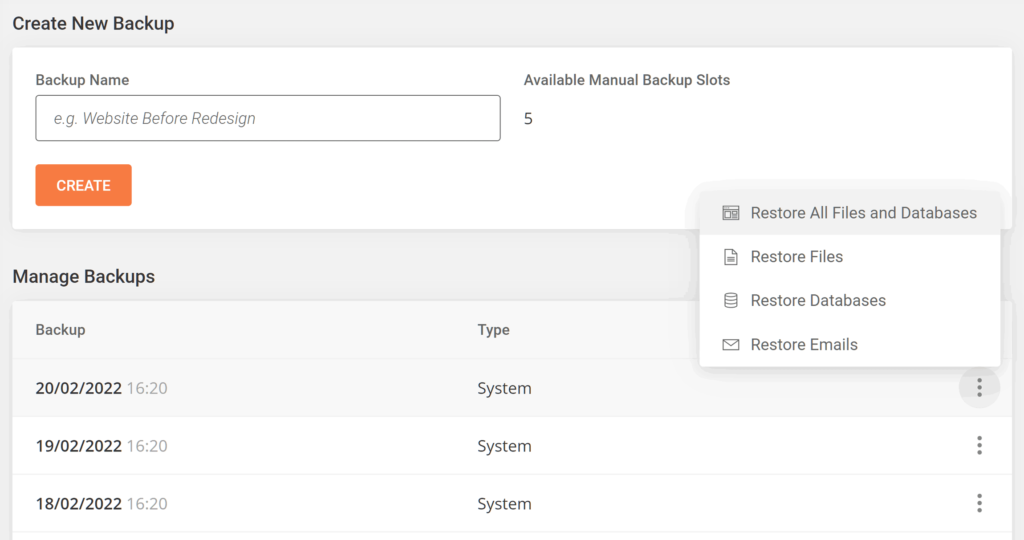
Thankfully, both hosts will automatically back up your website each day. All but the entry-level SiteGround StartUp plan also let you create backups on-demand — something that can be useful just before making a big change to your website. It’s possible to purchase credits for on-demand backups on the SiteGround StartUp plan.
Verdict: Kinsta wins as all of its plans include on-demand backups.
Data Center Locations
Both Kinsta and SiteGround have built their hosting infrastructure on the Google Cloud Platform.
As well as the performance benefits of this, you also get to host your website in one of the many Google Cloud Platform data centers that span the globe.
Choosing a data center location that’s close to your audience will reduce the time they have to wait for your pages to load. With Kinsta having 29 data center locations and SiteGround having data centers on four continents, this should be easier than with almost any other host.
Verdict: Kinsta wins because it has more data centers to choose from.
Content Delivery Network (CDN)
If your audience isn’t based in one location, or it’s based in a location that isn’t close to one of the Kinsta or SiteGround data centers, that’s not a problem.
Both hosts make it easy to use a CDN to duplicate and distribute your website files to a global network of servers.
Because there’s sure to be a CDN location that’s close to each of your visitors, they won’t have to wait for your website files to travel halfway around the world before your site is loaded.
While both hosts let you use a CDN, the Kinsta approach is much more user-friendly. It has its own CDN service built using Cloudflare, and, because of this, it only takes one click to enable the service.

SiteGround integrates with Cloudflare, but, in my experience, the process of enabling the CDN isn’t entirely straightforward. For one site, it only took a click or two to enable the CDN integration after I’d created a free Cloudflare account. For some reason, the same process didn’t work with my second site, and I had to contact support to resolve the issue. It didn’t take long, but it was an extra few steps that weren’t needed with Kinsta.
Verdict: Kinsta wins as the CDN is better integrated and is easier to set up.
Staging Sites
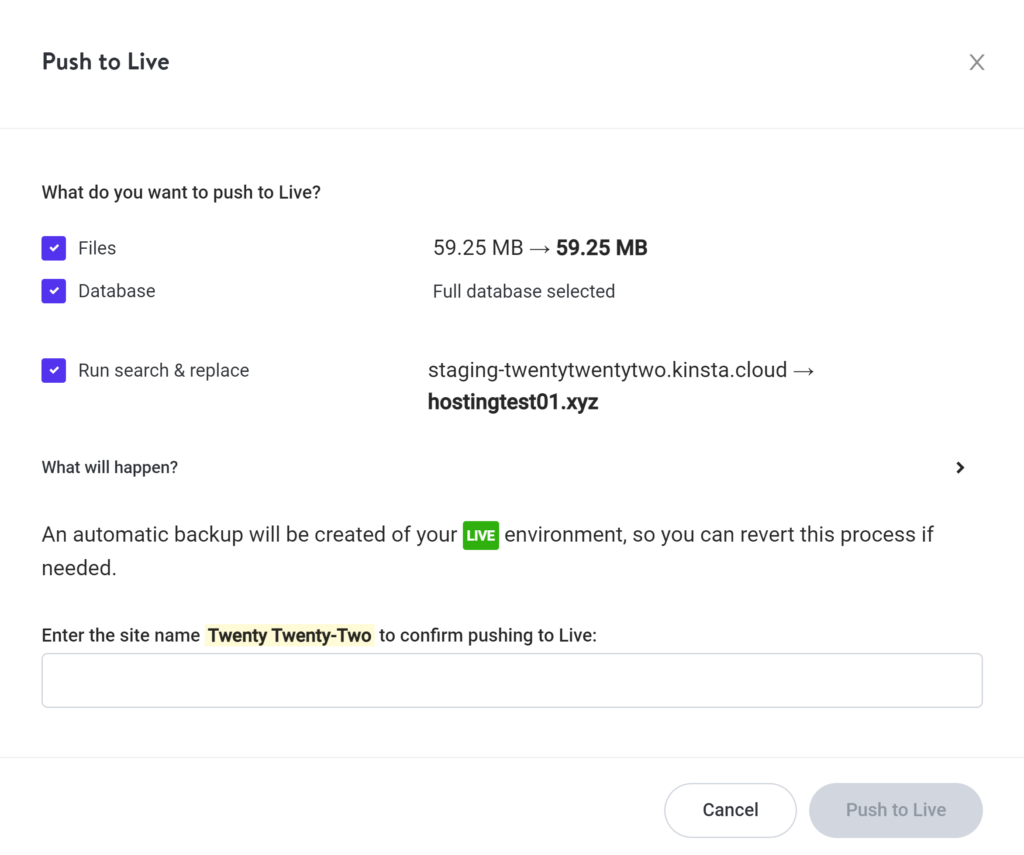
Both hosts also have a staging service on all of their plans, except for the entry-level SiteGround StartUp plan.
Because of this, you’ll have a private place to safely make and test website changes, away from your audience.
Transferring files between the sites is very easy with both hosts, making this a feature that’s well worth having access to.
Verdict: It’s a draw, as both hosts have a good staging feature, apart from the entry-level SiteGround plan.
SSL and Domain Names
Unlike some more budget-friendly shared hosts, such as Bluehost or DreamHost, neither SiteGround nor Kinsta will provide you with a free domain registration.
Instead, you’ll have to register one yourself. Because a .com domain can cost less than $10 a year to register, it’s hopefully not a deal-breaker.
Both hosts let you quickly and easily apply a free SSL certificate to your site and domain, and they also support premium SSL certificates too.
Verdict: Another draw as they both provide the same service in this area.
WordPress Website Migrations
Kinsta manages the migration of existing WordPress websites to its service. Each plan includes a set number of premium migrations, as well as access to free basic migrations.
SiteGround has a free migration tool that you can use to move a WordPress website to its services. It also has a paid migration service that costs $30 per site.
Verdict: Kinsta wins here because premium migrations are available at no extra cost.
Disallowed Plugins
To provide you with the highest levels of performance, Kinsta has banned a few plugins that could negatively affect its server configurations.
Typically, this includes caching and backup plugins, although there are others on the list. As Kinsta provides most of the features covered by these plugins, this shouldn’t be a problem. However, SiteGround doesn’t block any plugins.
Verdict: SiteGround wins because it doesn’t restrict plugin usage.
Support
Both hosts let you contact their support staff 24/7, but, while Kinsta only has an online messaging system for support, SiteGround also has a telephone support line. If you’re interested to know why Kinsta doesn’t offer telephone support, you can find out here.
Kinsta also has a security guarantee that covers your site getting hacked and other related issues.
SiteGround will monitor your site for security issues, but you have to pay for extra protection.
The level of support provided by SiteGround and Kinsta is very good. It’s definitely lots better than you get from most, if not all, cheaper shared hosting providers, and on par with other premium managed WordPress hosts.
Verdict: It’s a draw, because SiteGround provides telephone support while Kinsta doesn’t, but Kinsta has a more comprehensive security service included as standard.
Both hosts definitely have a great set of features. However, what are they like to use? Let’s find out…
User Experience
Both hosts make it very easy to start a new WordPress website. Whether you opt to have WordPress installed for you during the sign-up process, or install WordPress later on, it’s very easy to get started.
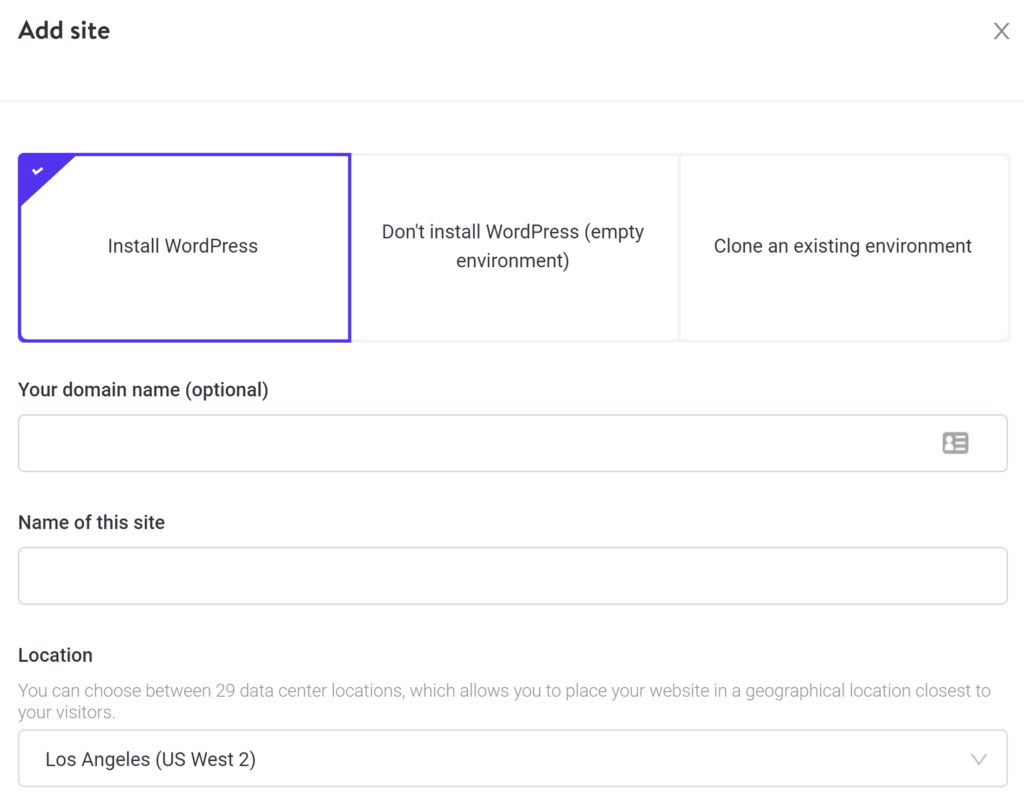
There’s one big difference in their approaches to installing WordPress, though. With Kinsta you get a very clean installation of WordPress, with just a page added for quickly clearing the cache.
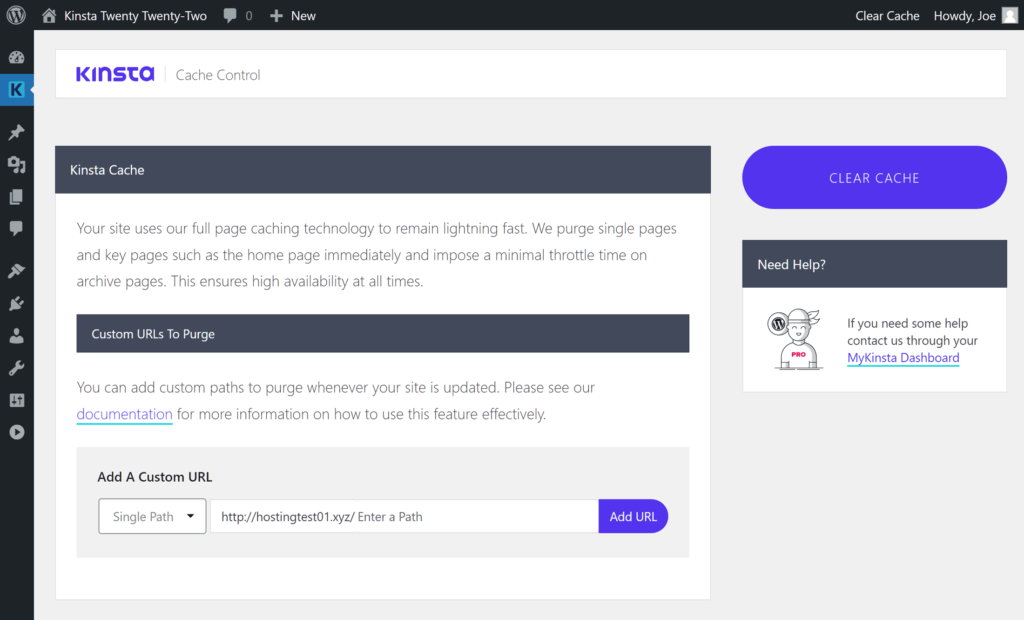
With SiteGround, you can create a relatively clean installation of WordPress, but you also get the option of using its wizard. The latter walks you through the options of choosing a theme and installing a few recommended plugins.
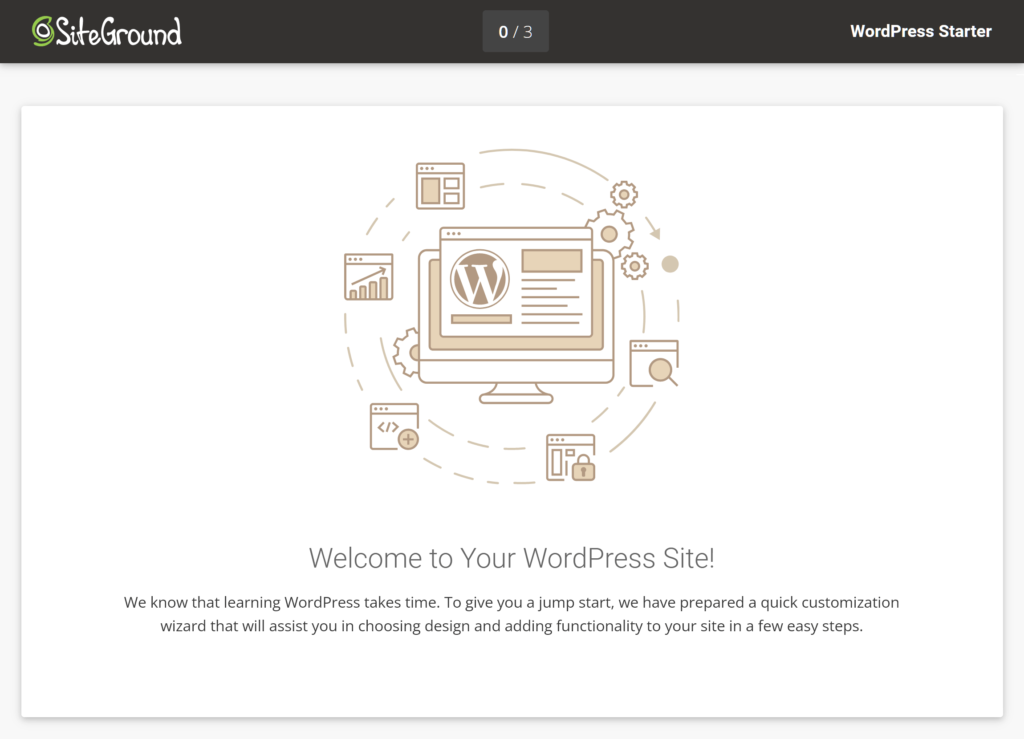
Regardless of which option you choose with SiteGround, the SG Optimizer plugin will be installed on your site. This adds some controls to your WordPress dashboard for managing the optimization and caching settings.
Both approaches have their pros and cons. Purists will prefer the Kinsta approach because you get a very clean WordPress installation, while new users may appreciate the SiteGround approach with its wizard and selection of useful recommended third-party plugins. However, the SiteGround clean install is still pretty good, and the SG Optimizer plugin isn’t too much of an intrusion.
The account area of the dashboards of both hosts are well designed too, but Kinsta makes it a bit easier to find your way around.
Verdict: Both hosts are very easy to use, so it’s a draw. However, new WordPress users may prefer the SiteGround approach while more experienced users should appreciate the Kinsta approach.
Pricing
Here’s a quick look at the prices of the Kinsta and SiteGround hosting plans…
Kinsta Pricing
Kinsta has ten hosting plans that you can pay for either monthly or yearly. Paying yearly gets you a discount, which is reflected in the prices listed below:
- Starter: From $29.17 a month for one website, 25,000 visits, 10 GB disk space and 50 GB of CDN bandwidth.
- Pro: From $58.33 a month for two websites, 50,000 visits, 20 GB disk space and 100 GB of CDN bandwidth.
- Business 1: From $95.83 a month for five websites, 100,000 visits, 30 GB disk space and 200 GB of CDN bandwidth.
- Business 2: From $187.50 a month for ten websites, 250,000 visits, 40 GB disk space and 300 GB of CDN bandwidth.
- View other plans on the Kinsta website.
If you go over the limits of your plan, you’ll be charged overage fees, which include $1 for every thousand visits and $2 for every GB of disk space.
SiteGround Pricing
SiteGround has three main WordPress hosting plans:
- StartUp: From $3.99 a month for one website, ~ 10,000 visits and 10 GB disk space.
- GrowBig: From $6.69 a month for unlimited websites, ~ 100,000 visits and 20 GB disk space.
- GoGeek: From $10.69 a month for one website, ~ 400,000 visits and 40 GB disk space.
All of the SiteGround plans have unmetered traffic. The monthly visit numbers aren’t hard limits, they’re more of a guideline of what size audience the plans are suitable for.
SiteGround allocates a certain amount of server and database resources to your account, depending on which plan you choose. If you consume too many of them, you may get asked to upgrade. You can find out more on the plan comparison page of the SiteGround website.
Both hosts have money-back guarantees, so you can try them without risk.
Kinsta is definitely more expensive than SiteGround, but one area where this makes a big difference is if you plan to host more than one website.
All but the entry-level SiteGround plan let you host unlimited websites (as long as you stay within the other limits of your plan). With Kinsta, you’d have to pay $95.83 a month or more to host five websites on your account.
Verdict: The SiteGround plans are cheaper, so it wins on price, but it really depends on what you’re looking for from a host and how much you’re willing to invest.
Final Thoughts
For the extra cost of the Kinsta plans, you do get faster loading times, a greater ability to handle load and a slightly more user-friendly experience compared with SiteGround. However, the website starter tool from SiteGround may make it more appealing to new WordPress users.
There are a few extra features with Kinsta too, including more data center options, an enhanced CDN service, and on-demand backups and staging on every plan.
But, even so, those advantages may not be enough for you to justify paying more for Kinsta, especially if you want to host multiple websites on your plan.
If that’s the case, SiteGround is still a really good host that I’m sure you won’t be disappointed with. That is unless you plan on hosting a feature-rich website with a heavyweight design or theme, which gets lots of traffic. In that case, a higher-performance host such as Kinsta may be essential.
Related Reading:
Used either of these two hosting services? Thoughts and experiences with each?
Discover more from WPMarmalade
Subscribe to get the latest posts sent to your email.



